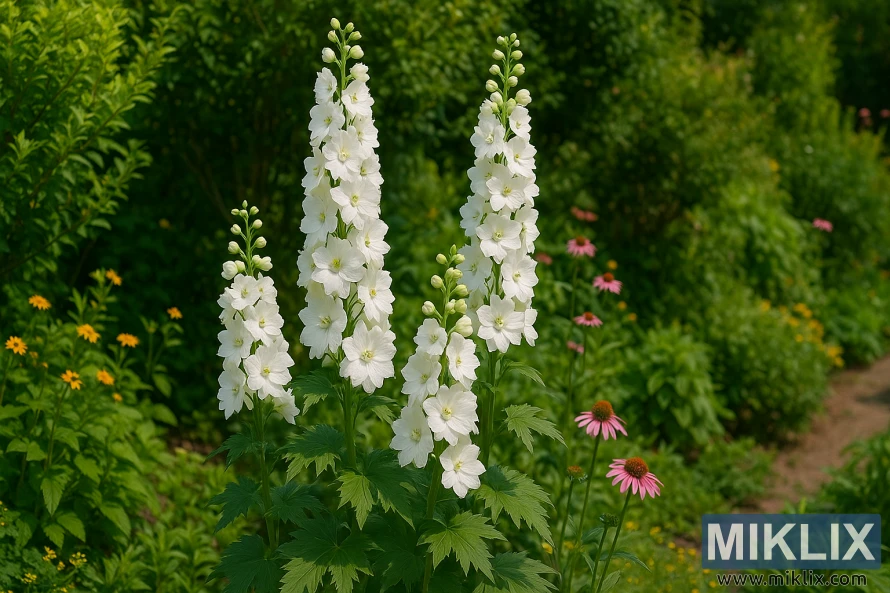Image: Delphinium 'Galahad' in a Cottage Garden Border
Published: October 25, 2025 at 4:20:57 PM UTC
A high-resolution garden scene featuring Delphinium 'Galahad' with tall white flower spikes growing in a lush cottage-style border, surrounded by coneflowers, rudbeckias, and layered greenery.
The image presents a luminous garden scene that captures Delphinium ‘Galahad’ in its purest and most elegant form. Bathed in soft, natural daylight, this landscape-oriented photograph focuses on a cluster of tall, stately flower spikes, each covered in pristine white blooms that rise like vertical columns from a lush base of green foliage. These classic perennials stand proudly at the heart of a cottage-style border, where they command attention while blending harmoniously into a tapestry of mixed perennials and textured greenery.
The ‘Galahad’ delphiniums are arranged in a natural yet deliberate spacing, with individual plants slightly staggered to create a sense of depth and flow. Each flower spike is densely packed with star-shaped blossoms, opening progressively from bottom to top. The petals are pure white — a hallmark of the cultivar — with a subtle translucency that catches and diffuses the sunlight. Their slightly ruffled edges and gentle curvature give the blooms a soft, almost cloud-like appearance, while the pale greenish-white centers add a delicate touch of contrast without breaking the purity of the palette. Toward the tops of the spikes, tightly closed buds form neat clusters, hinting at continued bloom and extending the plant’s visual interest.
The foliage at the base is lush and deeply lobed, typical of delphiniums, providing a verdant anchor for the soaring flower spikes. The leaves have a slightly serrated texture and a matte finish, their broad, palmate shape offering a textural counterpoint to the vertical elegance of the flower stems. They also serve as a rich green backdrop that accentuates the dazzling white of the blossoms above. The vertical lines of the delphiniums are softened and balanced by the surrounding planting, which includes bright yellow Rudbeckia (Black-eyed Susans) and soft pink Echinacea (coneflowers). These companion plants provide a complementary color contrast and seasonal continuity while enhancing the relaxed, naturalistic feel of the border.
The background is a blur of layered greens, with shrubs and perennials receding into the distance, giving the impression of a well-established garden. The dappled light filtering through leaves casts gentle shadows across the planting, creating a play of depth and texture that enhances the photograph’s realism and sense of place. A hint of a garden path on the right edge of the image suggests an inviting space meant to be explored — a living garden designed for both beauty and interaction.
Compositionally, the image strikes a perfect balance between structure and softness. The tall, upright spikes of Delphinium ‘Galahad’ form strong vertical lines that draw the eye upward, while the rounded shapes of the companion blooms and the layered greenery introduce gentle curves and horizontal flow. This interplay mirrors the best qualities of a cottage garden: abundant but intentional, exuberant yet harmonious.
The mood of the photograph is serene and timeless. The pure white blooms radiate freshness and elegance, symbolizing purity and grace in a planting scheme that feels both cultivated and natural. It is an image that not only celebrates the ornamental power of Delphinium ‘Galahad’ but also demonstrates how it thrives as a focal point within a diverse and thoughtfully composed garden border.
The image is related to: 12 Stunning Delphinium Varieties to Transform Your Garden

